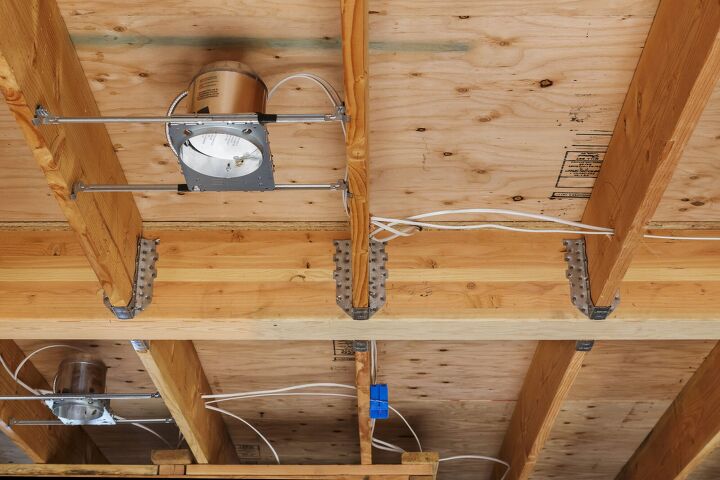Can IC Rated Lights Be Covered With Insulation? (Find Out Now!)

Downlights, also referred to as recessed lights, are a very popular and cost-effective way to provide lighting to your living spaces. They are installed in both new constructions and home renovation projects, providing many advantages to homeowners that lack the space for traditional lighting fixtures. Recessed lights can be easily tucked in between ceiling joists to add extra lighting and ambiance, with the need for pendant or freestanding fixtures.
However, since these lights are installed in your ceiling space, the heat that gets emitted is something to be mindful of. Before you add insulation into a wall or attic space over your downlights, it’s important that you are aware of all the manufacturer guidelines and best practices.
Fortunately, there are ways to safely cover downlights with insulation – in the form of IC rated lights. An IC rating indicates that the light is suitable to come into contact with your building insulation. In other words, an IC rated light can be adjoined and directly covered with insulation. Though, you should still always consult your manufacturer’s instructions to avoid any potential fire hazards.
Do You Need to Hire an Electrician?
Get free, zero-commitment quotes from pro contractors near you.

What Does IC Rating Mean?
“IC,” or insulated contact, rating is essentially a measurement that is used to determine whether or not recessed lights are suitable to come into contact with insulation. When a light is given this rating, it means that it can be safely operated without the risk of overheating, even when covered with insulation.
Fixtures that are IC rated are designed to shut off if the unit overheats, which prevents hot air from spreading to your insulation. As the unit cools down, it will kick back on automatically. Most IC rated lights are rated for 75 watts, with a 100 watt maximum. So long as you do not exceed the wattage limit, IC rated lights will reduce the risk of fires.
Can IC Rated Lights Be Covered with Insulation?
Before you install insulation, or can lights for that matter, it is crucial that you make sure that your recessed lights are IC rated. A can light that is IC rated can be safely installed in a ceiling that has insulation. This means that the light can make contact and be directly covered with insulation, which makes the installation much easier.
However, since IC rated lights usually have a 75 to 100 wattage capacity, you’ll need to pay attention to how much power your lights are consuming. So long as your IC rated lights are consuming less than 100 watts, they will reduce the risk of overheating and fires. In addition to preventing fires, IC rated lights can also save you money in the long run since they reduce the need for repairs.
Additionally, an insulated can light with an IC rating ensure that there’s no energy loss happening in your home.
Consider LED or CFL Lights
As you might already be aware, standard incandescent bulbs are hotter and heat up quicker than alternatives. They can also impact the temperature of your attic and the insulation in it. Opting for LED lights, which don’t overheat, use up 75% less energy, and last about 25 times longer than incandescent bulbs is a great solution that reduces the likelihood of your insulation overheating.
CFLs, or compact fluorescents, also don’t overheat, use 75% less energy, and last about 15 times longer than incandescent lights. This makes them a suitable alternative to incandescent bulbs when it comes to insulation.
Do LED Lights Need to be IC Rated?
Even though LED lights notoriously run cooler than other types of bulbs, LED recessed lights should still be IC rated. While LED bulbs produce substantially less heat than their incandescent (or even halogen) counterparts, they still produce heat. LED lights remain cool by distributing the heat away via a heat sink located at the base of the bulb. The heat disperses into the air, which helps keep the bulb itself cool in terms of temperature.
However, when you place an LED bulb in an enclosed space –like a recessed lighting fixture – the hot air doesn’t have anywhere to go. Like any other type of recessed lighting bulb, a non-IC rated LED recessed light pose the threat of fire. So long as you ensure that your fixture is IC rated, LED bulbs are perfectly safe.
It’s important to keep in mind, though, that if your fixture is not IC rated, it can still cause a fire – whether you use LED bulbs or a different type. Non-IC rated lights may overheat, which can result in the surrounding insulation catching fire.
How to Tell if Your Recessed Lighting is IC Rated
To find out if your recessed lighting fixture is IC rated, you need to remove both the lightbulb and the trim to look at the inner bulb fixture itself. After some digging, you should have a good idea whether the fixture is IC rated or not. Once you’ve removed the trim and the lightbulb, here’s how you can determine whether or not the fixture is IC rated:
Look at the label
The label is typically located on the inner chamber of the lighting fixture. Most IC-rated fixtures will have the letters “IC” in their model number, while non-IC rated fixtures will indicate that it’s “NON-IC”. The label will also notate the maximum wattage for the lighting fixture. In some cases, your fixture may not have a label. Fortunately, there are other methods for finding out if your fixture is IC rated or not.
Check the color
Checking the color of the fixture is a good way to find out if it’s IC rated. In most cases, non-IC rated fixtures are white, and IC rated fixtures are silver. Check out these 18 types of Christmas lights.
Holes or slits?
If you have or slits in the sides of the lighting fixture, odds are that it’s not IC rated. Older recessed fixtures were designed with holes to allow the air to leak out, preventing the unit from overheating. With these models, manufacturers state that they should never be covered with insulation since they have a high risk of causing fires.
When in doubt, you may need to have a professional come out to tell you whether your lighting fixture is IC rated or not. If you find that the fixture isn’t IC rated, we highly recommend replacing it as soon as possible.
Why Do Recessed Lights Need to be IC Rated?
In short, non-IC rated recessed lighting carry a major risk of fires. Recessed lighting, in particular, is very unique since the bulbs are installed in an enclosed space. If the lightbulb overheats, the fixture can dispel hot air. The hot air that leaks out of the fixture can then result in the surrounding insulation catching on fire.
Insulation Type
When it comes to whether or not it’s safe to cover your lighting with insulation, you should also be mindful of the specific insulation product you are using. Fiberglass insulation tends to melt when it comes into close contact with heat, such as the heat that is emitted from a downlight. Additionally, since it’s installed loosely between ceiling joists, the pathways of air that are created make it easy for a fire to spread rapidly.
Blown-in cellulose insulation, on the other hand, is treated with fire retardants and fits better around fixtures between joists and mineral wool insulation has the highest heat tolerance – over 1,800 degrees.
IC rating describes whether or not it’s safe to install recessed lighting in a ceiling that has conventional insulation, like fiberglass insulation. However, if you’re considering using a different form of insulation, such as spray foam insulation, you may need to seek the advice of a professional. While spray foam is an excellent insulation material that creates a strong barrier against heat loss, it may cause your lights to overheat.
Do You Need to Hire an Electrician?
Get free, zero-commitment quotes from pro contractors near you.

Final Thoughts
A downlight that is not IC rated cannot come into contact or be directly covered by insulation. If a NON-IC rated light is used, the insulation has to be cleared around and above the light to allow the heat to properly dissipate. With that said, to avoid thermal loss, a more difficult installation, and the potential for fires, always opt for IC rated downlights.
Related Articles

Jessica considers herself a home improvement and design enthusiast. She grew up surrounded by constant home improvement projects and owes most of what she knows to helping her dad renovate her childhood home. Being a Los Angeles resident, Jessica spends a lot of her time looking for her next DIY project and sharing her love for home design.
More by Jessica Stone











![Finishing Basement Without Permit [Is It Really Illegal?]](https://cdn-fastly.upgradedhome.com/media/2023/07/31/9070078/finishing-basement-without-permit-is-it-really-illegal.jpg?size=350x220)















